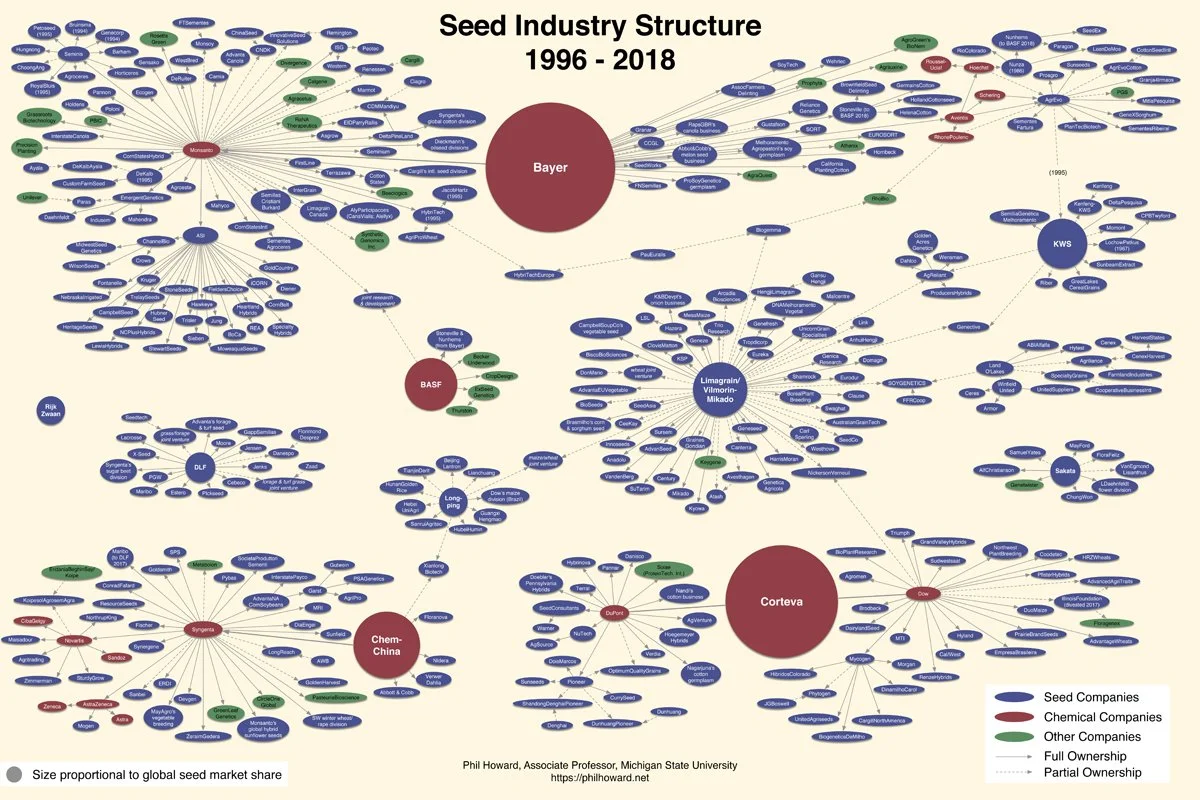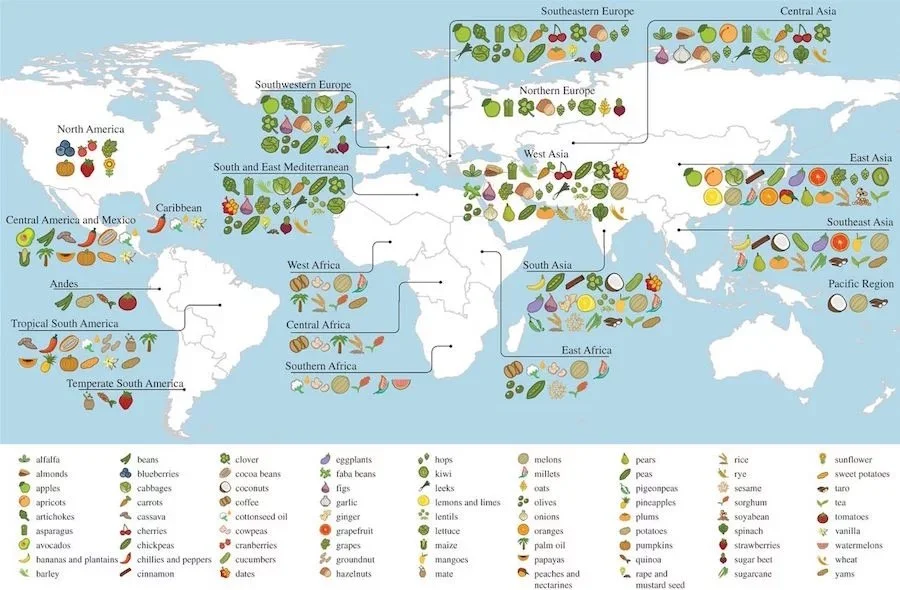Intellectual Property Rights (IPRs) privilege large corporations and laboratories, while restricting and undermining long-standing in situ crop development by farmers themselves.
What are IPRs?
The World Trade Organization (WTO) defines intellectual property as “creations of the mind,” such as technological inventions and artistic productions. The WTO’s 1995 Agreement on Trade-Related Aspects of Intellectual Property Rights (TRIPS) obligated all member countries to implement and enforce Intellectual Property Rights (IPRs), but provided some flexibility in the types of sui generis systems that countries could develop to meet these obligations. In addition to protecting novel inventions or creative works, however, corporations have pushed for IPRs to apply to various other realms—including patenting seeds and other forms of life—and have allowed companies to profit from common resources.
Through laws instituting IPRs, governments allow inventors to apply for patents, trademarks, or copyrights that prevent others from using their inventions, except in exchange for payment. In agriculture, patenting occurs through various mechanisms, including plant breeders' rights, trademarks, geographical indications and trade secrets. Only the company or institute that is granted a patent for a plant variety can produce, reproduce, sell, export or import that variety; if anyone else wants to do so, it requires a license or permit.
Effects of IPRs in agriculture
In theory, anyone with an interest in crop breeding could apply for seed patents. But many of the seed laws developed under dominant global frameworks contain strict definitions of who counts as a crop breeder, and the requirements for applying for seed patents are extremely stringent and often costly, with stipulations that only large and well-funded laboratories are likely to be able to meet. For example, in the US, applications for patents under the Plant Variety Protection (PVP) Act cost $5,150 and require a voucher sample of “3,000 untreated seeds that germinate at 85 percent or greater.” The scale and standardization required would likely be challenging for a farmer or in situ crop breeder to meet. Similarly, under plant varieties protection laws passed around the world, breeders must meet the requirement of genetic uniformity. To verify this, a breeder must be able to examine genetic regulators (genes that control how other genes behave). As a result, seed laws enable better-financed (often foreign) corporations and scientists to patent seeds. Moreover, plant variety protection laws’ criteria, such as uniformity and stability, actively undermine genetic diversity in agriculture.
Rather than encouraging free competition and lower prices to farmers, the process lends itself to monopolization, allowing large seed companies to gain more market share and charge higher prices. Already, four seed corporations control over half of the global seed market. Plant varieties protection laws in African countries will only exacerbate this trend, as large seed and agrochemical corporations are increasingly able to penetrate African markets.
Seed consolidation among a handful of major agrichemical corporations (source: Phil Howard, Seed Monopoly Chart, 2019)
While AGRA, AATF, and others claim to be helping small African seed companies thrive, at least some of these companies are linked to much larger corporations. For example, the largest seed company operating on the continent, SeedCo Ltd., was one of the beneficiaries of AGRA’s Program for Africa’s Seed Systems (PASS), which operated from 2006 to 2016. SeedCo is partially owned by the French multinational seed company Limagrain—one of the five largest seed companies in the world as of 2020—which bought a 28 percent share in the company in 2014.
Even companies that remain locally- or nationally-owned have experienced consolidation. In Burkina Faso, the seed company Neema Agricole du Faso S.A. (NAFASO) has benefited from AGRA support, such that 90 percent of commercial rice seed is now produced and marketed by the company. This would suggest that far from creating vibrant, competitive formal seed markets, AGRA support has helped to create monopolies at the national level.
In addition, some of the local seed companies and seed dealers that benefited from PASS use contract farming and outgrower schemes, which means that the resulting crops don’t fully belong to the farmer but to the company or dealer. While in some cases contract farming can be beneficial, it essentially reduces farming to assembly line production and often exposes farmers to considerable environmental and financial risks (as, for example, when crops fail due to low rainfall).
It’s also not true that people only innovate with the guarantee of private profits. The seeds in existence today have been domesticated, improved upon, and selected over many generations—not because of private property protections but because of human inventiveness and responsiveness to community and individual needs. Seed commercialization laws do not promote innovation in general, but instead protect and enable certain kinds of innovators—those corporations, labs, companies, and scientists whose only motivation is profit. As some scholars have pointed out, a restrictive definition of innovation (as limited to “modern,” market-based technologies developed in the Global North) parallels colonial racial ideologies that centered a Eurocentric, productivist vision of “improvement,” which was used as a justification for usurping land and resources. The role of racial capitalism is further reflected in the fact that most institutions that hold patents for novel crop varieties (and can therefore accrue profits for their sale) are based in the Global North, while most crop biodiversity is located in the Global South, where it has been maintained and developed through millennia of innovation by farmers.
Centers of crop domestication around the world (source: Crop Trust, How Much Do Countries Benefit From One Another’s Crop Diversity?, 2016)
Over many years of prioritizing “modern” cultivars developed in labs, the world—especially the Global South—has lost numerous plant species that were central to people’s lifeways and part of our common global heritage. Proponents of industrial agriculture and commercialized seed argue that crop diversity has in fact increased as a result of scientific advances in crop breeding, while critics have demonstrated decreases. Although one study suggests that there has not been a significant decrease in overall crop diversity as a result of seed commercialization, others estimate that 75 to 93 percent of traditional landraces of crops disappeared over the course of the 20th century. The plant varieties that have gone extinct were, by and large, developed over many generations and held in common as a part of cultural heritages. By contrast, the new varieties developed over the 20th century have been created by scientists in a handful of institutions—as such, there are critical issues of ownership, patent protection, and cultural meaning (or lack thereof). And while modern crop breeding may increase intraspecies diversity (i.e. distinct cultivars of one species), it focuses on a handful of key commercial crops, reducing interspecies diversity and neglecting other culturally important and ecologically well-adapted crops.
Sources and additional reading:
George Monbiot (1 Jan 1994), The Tragedy of Enclosure, Scientific American
Ruth Meinzen-Dick (14 Jun 2012), Elinor Ostrom's trailblazing commons research can inspire Rio+20, The Guardian
Elinor Ostrom (1990), Governing the Commons: The Evolution of Institutions for Collective Action
Gregory Akall (2021), Effects of development interventions on pastoral livelihoods in Turkana County, Kenya, in Pastoralism
UPOV (2011), Seminar on Plant Variety Protection and Technology Transfer: The Benefits of Public-Private Partnership
World Trade Organization (nd), Intellectual Property: Protection and Enforcement
Institute for Policy Studies (1999), Intellectual Property Rights and the Privatisation of Life
Jayashree Wattal (1999), Intellectual Property Rights and Agriculture: Interests of Developing Countries, World Bank
GRAIN (2015), UPOV 91 and other seed laws: a basic primer on how companies intend to control and monopolise seeds
USDA (nd), PVPO Services and Fees
UPOV (1991), International Convention for the Protection of New Varieties of Plants
Jack Mitchell, Iain G. Johnston, and George W. Bassel (2017), Variability in seeds: biological, ecological, and agricultural implications, in Journal of Experimental Botany
Crucible Group (1994), People, Plants, and Patents, IDRC
Phil Howard (2018), Global Seed Industry Changes Since 2013
SeedCo Group (nd), Our Story
The Ecologist (13 Oct 2014), Big Biotech's African seed takeover
FIAN International for the Global Network for the Right to Food and Nutrition and the Global Convergence of Land and Water Struggles, West Africa (Feb 2018), Business profits or diverse food systems? Threats to peasant seeds and implications in West Africa
Natural Resources Institute (2019), End of Program Evaluation for AGRA Africa’s Seed Systems Programs
Matt Canfield (forthcoming), The Ideology of Innovation: Philanthropy and Racial Capitalism in Global Food Governance, in Journal of Peasant Studies
Aaron Eddens (2019), White science and indigenous maize: the racial logics of the Green Revolution, in Journal of Peasant Studies
Mark van de Wouw et al. (2010), Genetic diversity trends in twentieth century crop cultivars: a meta analysis, in Theoretical and Applied Genetics
Food and Agriculture Organization (1999), What Is Happening to Agrobiodiversity? It is worth noting that the origin of these statistics has been questioned by subsequent studies, given the difficulty of accurately enumerating crop diversity losses and the fact that the statistics are difficult to trace back to an original study. See Colin K. Khoury et al. (2022), Crop genetic erosion: understanding and responding to loss of crop diversity, in New Phytologist for additional discussion of these numbers, and Paul J. Heald and Susannah Chapman (2009), Crop Diversity Report Card for the Twentieth Century: Diversity Bust or Diversity Boom? in SSRN and Andrew Porterfield (3 Sept 2015), Anti-GMO myth busted—We're not losing plant genetic diversity after all, for the Genetic Literacy Project (a pro-GMO advocacy group), for methodological critiques of the original unpublished report the FAO statistics were based on. In spite of issues with statistical estimates, many studies have confirmed

